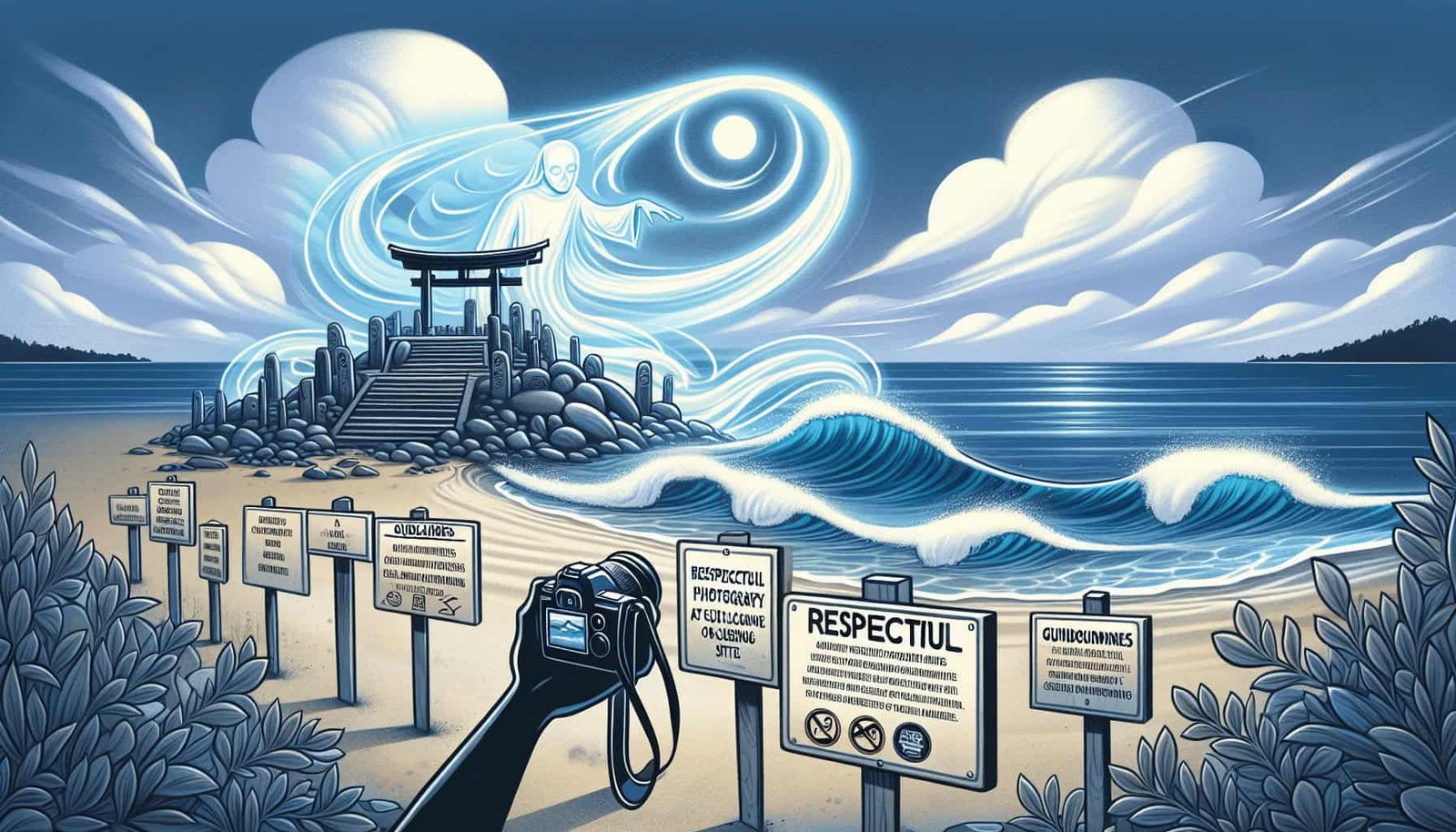So you’ve found yourself in front of a marvelously breathtaking beach, its shores steeped in history and culture. The azure waves crash invitingly against the sun-kissed sand, begging to be captured in a photograph that will forever encapsulate the beauty of this sacred place. But before you snap away, pause and consider – are there any guidelines for capturing these cultural or sacred beach sites with respect? In this article, we will explore the importance of mindful photography and offer some valuable insights into ensuring that our lens does justice to these extraordinary sites.
Understanding Cultural and Sacred Beach Sites
Definition of cultural and sacred beach sites
Cultural and sacred beach sites refer to coastal areas that hold deep historical, cultural, and spiritual significance for local communities. These sites often serve as important gathering places and are associated with traditional practices, rituals, and beliefs. They may be the sites of important events in local history, religious ceremonies, or ancestral burial grounds. These cultural and sacred beach sites are invaluable parts of a community’s heritage and should be treated with the utmost respect and reverence.
Importance of respecting these sites
Respecting cultural and sacred beach sites is of utmost importance for several reasons. Firstly, these sites are vital for the preservation of cultural heritage and the continuation of traditional practices. By respecting and protecting these sites, we ensure that future generations can learn from and appreciate the richness and diversity of different cultures.
Furthermore, these sites hold great spiritual significance for local communities. Disrespectful behavior, such as disregarding customs, invading personal space, or disregarding sacred rituals, can be deeply hurtful and offensive to these communities. Respecting cultural and sacred beach sites is crucial for fostering understanding, empathy, and mutual respect between cultures.
Challenges Faced by Cultural and Sacred Beach Sites
Damage caused by disrespectful photography
One of the significant challenges faced by cultural and sacred beach sites is the damage caused by disrespectful photography. Many visitors may unknowingly engage in intrusive behavior, such as standing on delicate structures, touching artifacts, or disrupting ongoing rituals, all in pursuit of capturing the perfect photo. These actions can cause irreversible damage to the sites and their cultural significance.
Cultural appropriation and exploitation
Another challenge posed is the issue of cultural appropriation and exploitation. Cultural appropriation occurs when aspects of one culture are adopted or commodified by another culture without understanding or respect, often perpetuating stereotypes or misrepresentations. This can be especially harmful when it comes to cultural and sacred beach sites, as the sanctity and cultural significance of these sites can be diluted or distorted for commercial gain.
Guidelines for Respectful Photography
Observe and follow local customs and traditions
To engage in respectful photography at cultural and sacred beach sites, it is essential to observe and follow local customs and traditions. This means taking the time to research and understand the cultural practices, dress codes, and norms of the community before visiting the site. By respecting and adhering to these customs, you demonstrate your appreciation and recognition of the community’s culture and heritage.
Seek permission before photographing
Always seek permission before taking photographs at cultural and sacred beach sites. It is respectful to approach local authorities or community leaders and inquire about any guidelines or restrictions on photography. By seeking permission, you show respect for the community’s authority and ensure you do not overstep any boundaries.
Avoid intrusive behavior
Respectful photography entails avoiding any intrusive behavior. This includes maintaining a respectful distance from individuals engaging in ceremonies or rituals, refraining from touching or moving any objects or artifacts, and refraining from disruptive or disrespectful behavior. It is crucial to be aware of your surroundings and maintain an attitude of reverence and quiet observation.
Use photography as a tool for education and preservation
Photography can be a powerful tool for education and preservation. When engaging in photography at cultural and sacred beach sites, aim to capture the beauty and essence of the site while simultaneously highlighting its cultural and historical significance. By sharing these photographs responsibly and accurately, you contribute to the preservation of cultural heritage and create awareness among others.
Understanding Local Customs and Traditions
Research and educate yourself about the local culture
Before visiting a cultural or sacred beach site, take the time to research and educate yourself about the local culture. Understanding the history, customs, and belief systems of the community will enable you to approach the site with respect and consideration.
Be aware of dress codes and modesty norms
Different cultures have varying standards of dress and modesty. It is essential to be aware of and abide by these dress codes when visiting cultural and sacred beach sites. Dressing appropriately not only shows respect for local customs but also allows for a more immersive experience, as you blend in with the local community.
Understand the significance of certain gestures or poses
Certain gestures or poses may have cultural or religious significance at cultural and sacred beach sites. It is crucial to educate yourself about these gestures and poses to avoid any unintentional disrespect. By understanding the meaning behind certain actions, you can ensure that your behavior is in line with local customs and traditions.
Seeking Permission
Approach local authorities or community leaders
When intending to photograph at cultural and sacred beach sites, it is vital to approach local authorities or community leaders. These individuals hold valuable knowledge and can provide guidance on any specific guidelines, limitations, or restrictions regarding photography. They can also offer insights into the cultural significance of the site and provide valuable information for capturing meaningful photographs.
Respect any restrictions or limitations imposed
If local authorities or community leaders impose any restrictions or limitations on photography, it is essential to respect and adhere to them. These restrictions are put in place to protect the cultural and sacred significance of the site and ensure that it remains a respectful and sacred space.
Engage with locals and build connections
Engaging with locals and building connections fosters a deeper understanding of the site and its cultural significance. By respectfully interacting with individuals from the local community, you create an environment of mutual respect, allowing for meaningful cultural exchanges. Building connections can provide valuable insights and perspectives that enrich your photographic experience.
Avoiding Intrusive Behavior
Maintain a respectful distance
Maintaining a respectful distance from individuals engaging in ceremonies or rituals is crucial to avoid intrusive behavior. Respecting personal space creates a harmonious environment and ensures that you do not disrupt or interfere with the cultural practices taking place.
Do not touch or move any objects or artifacts
Objects and artifacts found at cultural and sacred beach sites are often delicate and hold historical or spiritual significance. It is essential to refrain from touching or moving any of these items unless given explicit permission to do so. By treating these objects with care and respect, you contribute to their preservation for future generations.
Do not disturb ceremonies or rituals
Cultural and sacred beach sites may be the sites of important ceremonies or rituals. It is crucial to observe these events from a distance and avoid disrupting or interrupting them. These ceremonies often hold deep spiritual significance and should be respected as private and sacred moments for the community.
Using Photography as a Tool for Education
Capture the beauty and essence of the site
When engaging in photography at cultural and sacred beach sites, strive to capture the beauty and essence of the site. The natural landscape, architectural features, and cultural elements all contribute to the unique character and significance of the location. By capturing these aspects, you create a visual narrative that educates viewers about the site’s cultural and historical importance.
Highlight the cultural and historical significance
Photography can be a powerful medium for highlighting the cultural and historical significance of cultural and sacred beach sites. Through thoughtful composition and visual storytelling, you can convey the richness and depth of the site’s heritage. By emphasizing these aspects in your photographs, you contribute to raising awareness and appreciation for diverse cultures.
Share knowledge and create awareness
Photographs have the power to inspire and educate. By sharing your photographs responsibly, you can create awareness and share knowledge about cultural and sacred beach sites. This can be done through various platforms such as exhibitions, social media, or educational materials. By providing accurate information and context, you contribute to a more informed and respectful view of these sites.
Ethics of Photography at Cultural and Sacred Beach Sites
Avoid exploiting culture or promoting stereotypes
Ethical photography at cultural and sacred beach sites requires avoiding the exploitation of culture or the promotion of stereotypes. It is essential to approach these sites with cultural sensitivity and respect, ensuring that your photographs accurately represent the people and their traditions. Avoid perpetuating harmful stereotypes and prioritize authenticity and cultural understanding.
Respect privacy and confidentiality
When photographing at cultural and sacred beach sites, it is crucial to respect privacy and confidentiality. Ensure that you have obtained consent before photographing individuals, especially during personal or private moments. Respecting privacy fosters trust and maintains the sanctity of the site and its practices.
Consider the impact of publishing or sharing photographs
Before publishing or sharing photographs taken at cultural and sacred beach sites, carefully consider their impact. Reflect on how the photographs may be received and interpreted by different audiences. It is essential to be mindful of the potential consequences and ensure that the photographs are shared in a respectful and responsible manner.

Promoting Responsible Tourism
Support local businesses and initiatives
One way to promote responsible tourism at cultural and sacred beach sites is to support local businesses and initiatives. This can be as simple as purchasing locally made crafts or supporting sustainable tourism initiatives that contribute directly to the local community. By supporting local businesses, you help contribute to the economic well-being of the community and the preservation of the cultural heritage.
Leave no trace and minimize environmental impact
Responsible tourism also includes minimizing environmental impact. When visiting cultural and sacred beach sites, it is vital to leave no trace and ensure that your presence does not harm the surrounding environment. Respect any guidelines regarding waste disposal or protected areas and strive to leave the site in the same condition as you found it.
Conclusion
Respectful photography at cultural and sacred beach sites is crucial for preserving heritage and promoting understanding. By following guidelines and being mindful of local customs, traditions, and sensitivities, photographers can contribute to sustainable tourism and cultural appreciation. Through responsible photography, we have the power to preserve and celebrate the rich tapestry of human culture, fostering empathy, and promoting a more compassionate world.



